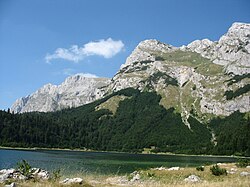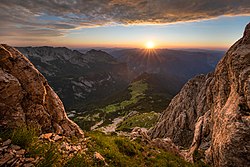Maglić (mountain)
 From Wikipedia - Reading time: 8 min
From Wikipedia - Reading time: 8 min
| Maglić | |
|---|---|
 View of Maglić's peak from Sutjeska National Park. | |
| Highest point | |
| Elevation | 2,386 m (7,828 ft) |
| Prominence | 51 m (167 ft) |
| Isolation | 0.56 km (0.35 mi) |
| Listing | Country high point |
| Coordinates | 43°16′52″N 18°44′13″E / 43.28111°N 18.73694°E |
| Geography | |
| Location | Bosnia and Herzegovina, Montenegro |
| Parent range | Dinaric Alps[1] |
| Geology | |
| Mountain type | Karst limestone |
Maglić (Serbian Cyrillic: Маглић, pronounced [mǎɡliːtɕ])[2] is a transboundary mountain in the Dinaric Alps, on the border of Bosnia and Herzegovina and Montenegro.
Its highest peak has an elevation of 2,388 m (7,835 ft) and is located in Montenegro. The second, its twin, is the more visited of the two and has an elevation of 2,386 m (7,828 ft). It is located in Bosnia and Herzegovina and is the highest peak of the country.[3] The mountain is oriented in a northwest–southeast direction.[4][5][6]
Geography
[edit]
Maglić is the highest mountain in Bosnia and Herzegovina. It is bounded by the river Sutjeska to the west, the Piva to the east-southeast and the Upper Drina to the north-northeast, with the Vučevo plateau (1,862 m (6,109 ft)) extending to the north.[6][7]
In Bosnia and Herzegovina, the nearest city is Foča, 20 km (12 mi) from the Maglić massif, while the nearest Montenegrin town is Mratinje.[8] Karst limestone formations in the region of limestone plateau are the general geological setting in the south and southwest of the area.[4]
The Maglić massif consists of two peaks, the Veliki Maglić (2,386 m (7,828 ft)) on the Bosnia and Herzegovina side and the Crnogorski Maglić (2,388 m (7,835 ft)) on the Montenegrin side. The Montenegrin part of the Maglić massif has formed the Trnovačko Lake, said to be "one of the most beautiful of Montenegro."[5][8] This lake is a glacier lake at an elevation of 1,517 metres (4,977 ft), is 700 metres (2,300 ft) long and 400 metres (1,300 ft) wide. The lake is drained from the Maglić, the Volujak and the Bioč mountain ranges. The north side of the lake which is open has the wooded Vratnice. The lake water has green blue colour.[8][9] The headwaters of Sutjeska River are in the canyon parts of Maglić Mountain. The mountain is bounded by the Sutjeska river on the north and west, by the Volujak mountain on the southwest, by the Drina River and Piva River on the east and by the Mratinjska Uvala valley on the south.[5][8]

The rich forests on the mountainside consist of the Perućica forest, a protected reserve within the Sutjeska National Park, which is the oldest and one of the two last remaining primeval forests in Europe. The northwestern slope has thick coniferous and beech trees up to elevation 1,600 m (5,249 ft), while in the other directions the hill slopes are very steep, barren and rocky. Pastures are found at elevations above 1,600 metres (5,200 ft) in the plateaus.[7][10] The mountain peak is accessible through the park and is visited by mountaineers and nature lovers. Most of the routes to the peak require two days of hiking. Mountaineering access to the summit of the Maglić massif is only from the southern side, which has rich vegetation of grass and mountain pine. From the top of the peak, are scenic vistas of Volujak, Bioč, Trnovačko Lake, Durmitor, apart from the Bosnian mountains in the north and northwestern direction which can be seen.[8]
Protection
[edit]Maglić is important feature of the Sutjeska National Park, which is the first national park within Bosnia and Herzegovina, established in 1962. The park is drained by the Sutjeska River, running through the valley of Tjentište.[6][7]
See also
[edit]References
[edit]- ^ "Maglic" on Peakbagger 27 September 2011
- ^ Pravopisna komisija, ed. (1960). "Maglić". Pravopis srpskohrvatskoga književnog jezika (Fototipsko izdanje 1988. ed.). Novi Sad, Zagreb: Matica srpska, Matica hrvatska. p. 412.
- ^ "Maglić/Bioč/Volujak/Trnovački Durmitor/Vlasulja". www.summitpost.org. Climbing, Hiking & Mountaineering : SummitPost. Retrieved 15 June 2020.
- ^ a b "Maglic". Encyclopædia Britannica. Retrieved 10 July 2011.
- ^ a b c "Maglić Mountain". mountainsmounts.com. Retrieved 10 July 2011.
- ^ a b c "National Parks". The Sutjeska National Park. Consul General of BiH in Chicago. Archived from the original on 13 June 2011. Retrieved 7 July 2011.
- ^ a b c "National Park Sutjeska". Highlander. Archived from the original on 11 July 2011. Retrieved 7 July 2011.
- ^ a b c d e "Maglić / Bioč / Volujak / Trnovački Durmitor / Vlasulja". summitpost.org. Retrieved 11 July 2011.
- ^ "Green Visions and Outdoor Adventure and Culture Guide 2008" (PDF). Sutjeska National Park Hike. Green Visions. Archived from the original (PDF) on 26 March 2012. Retrieved 11 July 2011.
- ^ "Sutjeska National Park". Visitsrajevo.ba. Archived from the original on 20 January 2013. Retrieved 11 July 2011.
 KSF
KSF

